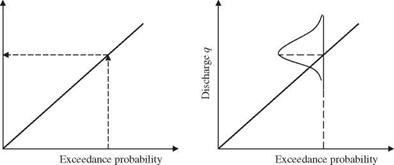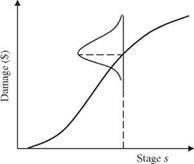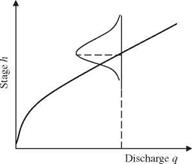Flood-damage-reduction projects
A flood-damage-reduction plan includes measures that decrease damage by reducing discharge, stage, and/or damage susceptibility (U. S. Army Corps of Engineers, 1996). For federal projects in the United States, the objective of the plan is to solve the problem under consideration in a manner that will “… contribute to national economic development (NED) consistent with protecting the Nation’s environment, pursuant to national environmental statutes, applicable executive orders, and other Federal planning requirements” (U. S. Water Resources Council, 1983). In the flood-damage-reduction planning traditionally done by the U. S. Army Corps of Engineers (Corps), the level of protection provided by the project was the primary performance indicator (Eiker and Davis, 1996). Only projects that provided a set level of protection (typically from the 100-year flood) would be evaluated to determine their contribution to NED, effect on the environment, and other issues. The level of protection was set without regard to the vulnerability level of the land to be protected. In order to account for uncertainties in the hydrologic and hydraulic analyses applied in the traditional method, safety factors, such as freeboard, are applied in project design in addition to achieving the specified level of protection. These safety factors were selected from experience-based rules and not from a detailed analysis of the uncertainties for the project under consideration.
The Corps now requires risk-based analysis in the formulation of flood – damage-reduction projects (Eiker and Davis, 1996). In this risk-based analysis, each of the alternative solutions for the flooding problem is evaluated to determine the expected net economic benefit (benefit minus cost), expected level of protection on an annual basis and over the project life, and other decision criteria. These expected values are computed with explicit consideration of the uncertainties in the hydrologic, hydraulic, and economic analyses used in plan formulation. The risk-based analysis is used to formulate the type and size of the optimal plan that will meet the study objectives. The Corps policy requires that this plan be identified in every flood-damage-reduction study. This plan may or may not be the recommended plan based on “additional considerations” (Eiker and Davis, 1996). These additional considerations include environmental impacts, potential for fatalities, and acceptability to the local population.
In the traditional approach to planning flood-damage-reduction projects, a discharge-frequency relation for the project site is obtained through frequency analysis at or near gauge locations or through frequency transposition, regional frequency relations, rainfall-runoff models, or other methods described by the U. S. Army Corps of Engineers (1996) at ungauged stream locations. Hydraulic models are used to develop stage-discharge relations for the project location. Typically, one-dimensional steady flows are analyzed with a standard step-backwater model, but in some cases complex hydraulics are simulated using an unsteady-flow model or a two-dimensional flow model. Stage-damage relations are developed from detailed economic evaluations of primary land uses in the flood plain, as described in U. S. Army Corps of Engineers (1996). Through integration of the discharge-frequency, stage-discharge, and stage – damage relations, a damage-frequency relation is obtained. By integration of the damage-frequency relations for without-project and various with-project conditions, the damages avoided by implementing the various projects on an average annual basis can be computed. These avoided damages constitute the primary benefit of the projects, and by subtracting the project cost (converted to an average annual basis) from the avoided damages, the net economic benefit of the project is obtained.
The traditional approach to planning of flood-damage-reduction projects seeks to maximize net economic benefits subject to the constraint of achieving a specified level of protection. That is, the flood-damage-reduction alternative that maximizes net economic benefits and provides the specified level ofprotec – tion would be the recommended plan unless it was unacceptable with respect to the additional considerations.
Risk-based analysis offers substantial advantages over traditional methods because it requires that the project resulting in the maximum net economic benefit be identified without regard to the level of protection provided. Therefore, the vulnerability (from an economic viewpoint) of the flood-plain areas affected by the project is considered directly in the analysis, whereas environmental, social, and other aspects of vulnerability are considered through the additional considerations in the decision-making process. In the example presented in the Corps manual on risk-based analysis (U. S. Army Corps of Engineers, 1996), the project that resulted in the maximum net economic benefit provided a level of protection equivalent to once, on average, in 320 years. However, it is possible that in areas of low vulnerability, the project resulting in the maximum net economic benefit could provide a level of protection less than once, on average, in 100 years. A more correct level of protection is computed in the risk-based analysis by including uncertainties in the probability model of floods and the hydraulic transformation of discharge to stage rather than accepting the expected hydrologic frequency as the level of protection. This more complete computation of the level of protection eliminates the need to apply additional safety factors in the project design and results in a more correct computation of the damages avoided by implementation of a proposed project.
Monte Carlo simulation is applied in the risk-based analysis to integrate the discharge-frequency, stage-discharge, and stage-damage relations and the respective uncertainties. These relations and the respective uncertainties are shown in Fig. 8.16. The uncertainty in the discharge-frequency relation is determined by the methods used to compute confidence limits described by the Interagency Advisory Committee on Water Data (1982), which are reviewed in Sec. 3.8. For gauged locations, the uncertainty is determined directly from the gauge data; for ungauged locations, the probability distribution is fit to the estimated flood quantiles, and an estimated equivalent record length is used to compute uncertainty through the confidence-limits approach. The uncertainty in the stage-discharge relation is determined from gauge data, if available, calibration results if a sufficient number of high-water marks are available, or Monte Carlo simulation considering the uncertainties in the component input variables (Manning’s n and cross-sectional geometry) for the hydraulic model (e. g., U. S. Army Corps of Engineers, 1986). The uncertainty in the stage-damage relation is determined by using Monte Carlo simulation to aggregate the uncertainties in components of the economic evaluation. At present, uncertainty distributions for structure elevation, structure value, and contents value are considered in the analysis.
The Monte Carlo simulation procedure for the risk-based analysis of flood – damage-reduction alternatives includes the following steps applied to both without-project and with-project conditions (U. S. Army Corps of Engineers, 1996):
1. A value for the expected exceedance (or nonexceedance) probability is selected randomly from a uniform distribution. This value is converted into a random value of flood discharge by inverting the expected flood-frequency relation.
|
|
|
|
|
|
Figure 8.16 Uncertainty in discharge, stage, and damage as considered in the U. S. Army Corps of Engineers risk-based approach to flood-damage reduction studies. (After Tseng et al., 1993.)
2. A value of a standard normal variate is selected randomly, and it is used to compute a random value of error associated with the flood discharge obtained in step 1. This random error is added to the flood discharge obtained in step 1 to yield a flood-discharge value that includes the effect of uncertainty in the probability model of floods.
3. The flood discharge obtained in step 2 is converted to the expected flood stage using the expected stage-discharge relation.
4. A value of a standard normal variate is selected randomly, and it is used to compute a random value of error associated with the flood stage computed in step 3. This random error is added to the flood stage computed in step 3 to yield a flood stage that includes the effects of uncertainty in the stage – discharge relation and the probability model of floods. If the performance of a proposed project is being simulated, level of protection may be determined empirically by counting the number of flood stages that are higher than the project capacity and dividing by the number of simulations.
5. The flood stage obtained in step 4 is converted to the expected flood damage using the expected flood-damage relation. If the performance of a proposed project is simulated, the simulation procedure may end here if the simulated flood stage does not result in flood damage.
6. A value of a standard normal variate is selected randomly, and it is used to compute a random value of error associated with the flood damage obtained in step 5. This random error is added to the flood damage obtained in step 5 to yield a flood-damage value that includes the effects of all the uncertainties considered. If the flood-damage value is negative, it should be set equal to zero.
Steps 1 through 6 are repeated as necessary until the values of the relevant performance measures (average flood damage, level of protection, probability of positive net economic benefits) stabilize to consistent values. Typically, 5000 simulations are used in Corps projects.
The risk-based approach, summarized in steps 1 through 6, has many similarities with traditional methods, particularly in that the basic data and discharge – frequency, stage-discharge, and stage-damage relations are the same. The risk – based approach extends traditional methods to consider uncertainties in the basic data and relations. The major new task in the risk-based approach is to estimate the uncertainty in each of the relations. Approaches to estimate these uncertainties are described in detail by the U. S. Army Corps of Engineers (1996) and are not trivial. However, the information needed to estimate uncertainty in the basic components variables is often collected in traditional methods but not used. For example, confidence limits often are computed in flood-frequency analysis, error information is available for calibrated hydraulic models, and economic evaluations typically are done by studying in detail several representative structures for each land-use category, providing a measure of the variability in the economic evaluations. Therefore, an excessive data-analysis burden relative to traditional methods may not be imposed on engineers and planners in risked-based analysis.
Because steps 1 through 6 are applied to each of the alternative flood-damage – reduction projects, decision makers will obtain a clear picture of the tradeoff among level of protection, cost, and benefits. Further, with careful communication of the results, the public can be better informed about what to expect from flood-damage-reduction projects and thus can make better-informed decisions (U. S. Army Corps of Engineers, 1996).









Leave a reply